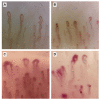Biomarkers in Systemic Sclerosis: An Overview
- PMID: 37886934
- PMCID: PMC10604992
- DOI: 10.3390/cimb45100490
Biomarkers in Systemic Sclerosis: An Overview
Abstract
Systemic sclerosis (SSc) is a complex autoimmune disease characterized by significant fibrosis of the skin and internal organs, with the main involvement of the lungs, kidneys, heart, esophagus, and intestines. SSc is also characterized by macro- and microvascular damage with reduced peripheral blood perfusion. Several studies have reported more than 240 pathways and numerous dysregulation proteins, giving insight into how the field of biomarkers in SSc is still extremely complex and evolving. Antinuclear antibodies (ANA) are present in more than 90% of SSc patients, and anti-centromere and anti-topoisomerase I antibodies are considered classic biomarkers with precise clinical features. Recent studies have reported that trans-forming growth factor β (TGF-β) plays a central role in the fibrotic process. In addition, interferon regulatory factor 5 (IRF5), interleukin receptor-associated kinase-1 (IRAK-1), connective tissue growth factor (CTGF), transducer and activator of transcription signal 4 (STAT4), pyrin-containing domain 1 (NLRP1), as well as genetic factors, including DRB1 alleles, are implicated in SSc damage. Several interleukins (e.g., IL-1, IL-6, IL-10, IL-17, IL-22, and IL-35) and chemokines (e.g., CCL 2, 5, 23, and CXC 9, 10, 16) are elevated in SSc. While adiponectin and maresin 1 are reduced in patients with SSc, biomarkers are important in research but will be increasingly so in the diagnosis and therapeutic approach to SSc. This review aims to present and highlight the various biomarker molecules, pathways, and receptors involved in the pathology of SSc.
Keywords: autoimmune disease; chemokines; interleukines; systemic sclerosis (SSc).
Conflict of interest statement
The authors declare no conflict of interest.
Figures





References
-
- Jaeger V.K., Tikly M., Xu D., Siegert E., Hachulla E., Airò P., Valentini G., Matucci Cerinic M., Distler O., Cozzi F., et al. Racial differences in systemic sclerosis disease presentation: A European Scleroderma Trials and Research group study. Rheumatology. 2020;59:1684–1694. doi: 10.1093/rheumatology/kez486. - DOI - PubMed
Publication types
LinkOut - more resources
Full Text Sources
Miscellaneous

